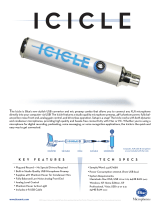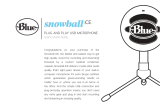Page is loading ...

The Yeti microphone was conceived as the ultimate, state-of-the-art USB microphone, a recording tool that anyone
from a casual user to a professional musician could use in almost any recording environment. With the inclusion of
such features as gain control and zero-latency headphone output. It had to sound amazing. And of course it had to
look . . .
Blue.
In other words, it had to look and perform like nothing else on the market.
Before I even began work on the project, indeed, even before the project had a name, the mic had to be designed.
Through a tortuous process of scribbles, sketches and squabbles, Blue’s mysterious Design and Engineering Dept.
Unlike other microphone
companies, Blue has
always refused to follow
accepted convention
by naming its products
after a series of seem-
ingly random letters
and numbers. Instead
of the C110-EX, we had
-
sal shockmount (a device that suspends the mic and dampens surrounding vibrations) with the sublime moniker of
“Ralph the Wonder Mount.” It sold very well.
Naming sessions usually include a group of people in a small, barely air conditioned room with a whiteboard on the
wall and too many cups of coffee. Ideas are brought forth and dutifully recorded. Or ignored. Going off on tangents is
not uncommon, as are names that would not be acceptable in most churches, but eventually a few names stick and
a consensus is reached. The Yeti was born of this process. To this day I don’t know who thought of the name — it was
shape of the mic.
Now that we had a name and a pretty good idea of the look of the mic, the creative process for the packaging could
begin. Aside from conveying to the consumer the immediate, “What is this product and what does it do,” I felt that
the overall theme of the artwork had to
emphasize a friendly, personable ap-
proach. The Yeti is a physically large mic
with a tremendous amount of features.
Lots of knobs. Lots of options. Something
like this could easily intimidate consumers,
so like the Yeti of lore, we needed to be
warm and fuzzy. I hit upon the idea of cre-
ating a family of Yeti (Yetis?) that would
make the user more at home and comfort-
able exploring all of the amazing things
the Yeti can do.
I began by researching Yeti mythology and
how the character had been visually in-
terpreted. (Note to readers: I don’t believe
the Yeti really exists. Sorry. I think it’s the
mistaken identity of the endangered Hima-
layan Brown Bear, which is prone to walk-
-
lustrated versions of the Yeti abound, from
outright scary to cuddly-adorable. Some
Preliminary Yeti Sketches
The Blue Microphones Family
The author is the “Creative Czar” for Blue Microphones, a specialist company that manufactures
microphones for home and studio use. Its latest semi-pro consumer product is the Yeti. The company
came in to the show the mic to The Times recently, and we were so taken with the package design
(and associated coasters) that we wanted to know more about the thinking behind it. Here is the full story.
5.20.10
Making a microphone cuddly: a Yeti

are well known: the Gama-Go Yeti is particularly well designed
and appears on everything from shirts to vinyl toys. I compiled
as many Yeti images as possible in order to not (ahem) ape
other existing Yeti.
It was now time to sketch.
Amazing as it may seem in this digital age, I began with a
pencil and a piece of paper, something no mouse or electronic
tablet has been able to improve upon. I started with what I call
the “Basic” Yeti, a somewhat bemused, friendly fellow that you
could bring home to mom. It took quite a few sketches to hone
him into what I saw in my mind to begin with, but he eventually
took shape and I scanned a rough sketch into the computer.
While I was sketching him out, other, more specialized Yeti be-
gan to form in my mind; these too would be sketched out and
digitized one by one.
With the Yeti now safely caged on my desktop, I simplied the
shape of the Yeti with a series of basic shapes, mostly com-
prised of circles, ovals and simple lineforms. All of this was done
in outline (wireframe) view. Much time was spent rening and
combining shapes until I had what I wanted, and along the way I
stumbled upon other shapes and patterns that would eventually
work their way into the other Yeti family members. It’s a mostly
intuitive process that I wish I could explain in words, which I’d do
if I could only spell, so it’ll have to remain a mystery.
At this point, with a few of the Yeti drawn in outline form, it was time to turn attention to the actual package. Blue’s
wonderful idiosyncratic approach to things is to develop a unique look for its products, from the actual design of the
mics all the way down to their packaging. Thus, no two Blue packages have the same look; aside from the Blue logo
and a blue-colored band running around the packages, there is no uniform series design look. This approach does
have its occasional drawbacks, but remains true to one of Blue’s founding principals, that every person has their own
unique individual style and sound.
Part of that critical identity to this or any other Blue product was to devise a
strong typographic quality to enhance the brand. Choosing the right fonts is
crucial to any project, and the process of spending hours reviewing different
typefaces is, well, dare I say it, fun (perhaps that’s why many designers are
single). Fonts are the visual equivalent of a box of assorted chocolates: sweet,
immediate, and a bit of a treasure hunt. It’s simply a matter of weeding through
all the bad ones and nding the gems. There are a lot of typefaces out there
and 90% of them are badly designed or won’t withstand the winds of time and
vagaries of style. And no two designers will agree on the
remaining 10%, prompting heated discussions at parties
— ultimately another reason why most designers are still
single.
The font chosen for the Yeti was the Pennsylvania font
family, designed by the Font Bureau in Boston. I was
drawn to it by the variety of weights within the family and
the way some of the lower case letters evoked a gure
walking upright, which was too nice a visual metaphor to
pass up. I went with a lower case spelling of Yeti on the
front of the box, as it was a visually friendlier way of introducing the product.
Capitalizing it was far too formal for a rst date with the consumer.
Next up: color. Yeti follows in the tradition of other recent Blue consumer product names with an arctic-like theme:
Snowball, Snowake, Icicle (we like to think of it as our way of combating global warming). Anyhow, these products
pretty much cornered the market in the blue color spectrum, so I gravitated towards a cousin color, teal. Aqua, if you
Yeti Outlines
yes
Virginia,
there is a
yeti
Pennsylvania
PMS 7466

prefer. Leang through a booklet of Pantone Col-
ors (specialized printing inks that are created from
precise amounts of specic colors) I found a beauti-
ful shade of light aqua-teal that reminded me of light
reected through glacial ice, which may someday join
the Yeti in the annals of legendary sights.
Working with James Chan, our extremely talented and
diabolical Product Designer, we were able to deter-
mine the package size and shape — in this case an ex-
citing rectangle. As with the Yeti characters, I began
sketching out the box layout by hand. I knew I wanted
a large image of the mic on the front cover and we
needed to have a simple way to convey all of the mic’s
features on the back. I envisioned the Yeti characters
inhabiting one panel and some sort of chart showing
the various applications the mic was suited for. But
actually putting this all together is another matter
entirely. Approaching something like this is a bit akin
to sailing off into uncharted waters and hoping your
gallantly designed ship doesn’t sail off the edge of
the box. This is a messy period where potential visual
ideas butt up against the harsh realities of available
space, the needs of other departments within the
company (everyone has their 2¢ on the ideal layout)
and the pure artistic vision residing in my head. It’s all
a bit nerve-wracking, albeit in a slow motion sense, as
the process takes, well,
forever
. Blue prides itself on
creating everything in-house: print and web design, il-
lustration, copy writing and production are all housed
under one roof. Our amazing Senior Designer, Ben
Bain, is not only responsible for much of Blue’s creative
output, but also coordinates the Blue Creative Staff
and makes sure they never leave the premises (not that
they’d get past the alligator-infested moat anyway).
During this time the actual Yeti mic was still going
through the rst rounds of preproduction, so at rst all I
had to work with were 3-D CAD drawings as placeholders
for real pictures of the mic. The rst, primitive rough for
the front cover sported a teal background with the name
Yeti reversed out. As you can see below, the mic at this
point was still evolving, and had not shed its juvenile coat
of black. Not happy with the teal background, I reversed
everything and went with white, which looked far more
refreshing. The back panel, showing a side view of the
Yeti, had the beginnings of the type design in place, but
there was still a ways to go.
Over the next few months the package evolved. I eshed out and added more Yeti characters and geared them towards
representing different archetype users: Rocker Yeti, Businessman Yeti, Out-in-the-eld Yeti, Techie Yeti, and so on. The
Raging Yeti is based on someone who actually works at Blue. The Techie Yeti’s glasses are modeled after Buddy Holly.
It’s quite the family tree. Originally each Yeti had their own groovy background pattern, but this ultimately proved too
distracting and was jettisoned in favor of just solid colors.
Text was nalized, laid out, moved around, positioned, and then moved again. In order to satisfy the requirements
to let Yeti loose in Canada, all the text in the box had to be bilingual — English/French. This adds another layer of
complexity and guarantees even more reshufing of blocks of text. The chart describing the recording modes was
laid out, and in the continuing effort to be more user-friendly, the Yeti characters were again brought out to illustrate
Early Package Sketches
Front Panel Evolution

each salient application. Owing to space limitations, I de-
cided to move the block of localized languages (bullet points
describing the mic’s features in ve languages — a necessary
evil if we are to achieve true global domination) to the Yeti
characters side, which had the unpleasant effect of making
a less than desirable aspect ratio for each gure. I decided
to remedy this by adding a section in the middle with some
more humorous/descriptive text, hitting upon the concept of a
dictionary denition, since some people (I won’t name names)
had no idea what a Yeti was. Bigfoot yes, Yeti, no. And what
are those Himalayan things you’re referring to?
Up until this point I had been employing placeholder images
of the mic that I shot in a primitive little studio in my garage
at home, but I was nally able to get an actual production
model of the mic for professional photography. One photo
session and some Photoshop touch ups later, and I had more
photos in my possession than any Yeti tracker on the planet.
Final pictures were dropped in, last-second tweaks taken care
of, and the package was sent to the printer. Fingers crossed,
digital proofs were approved and a small run of preproduction
boxes were printed and ultimately approved. We had a pack-
age!
Then there’s the Yeti manual. But that’s another story.
All in all, the process to bring the Yeti packaging to life, from
initial sketches to nal nished artwork, took about two and a
half months and untold man-hours. I think it was worth it. The packaging has been quite successful, sales are through
the roof and the Yeti characters now grace T-shirts, beer coasters, stickers and anything else we can think of. I sup-
pose the fact that the microphone looks and sounds amazing may have something to do with it, but I prefer to think
that people are purchasing it in order to frame the packaging on their living room wall. I mean, that’s what
I
did.
Fig 8.
The Complete Package, Ready to be Released Into the Wild
T
he Final Yeti Lineup
/




